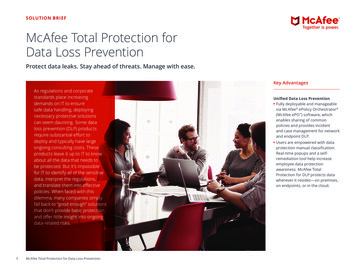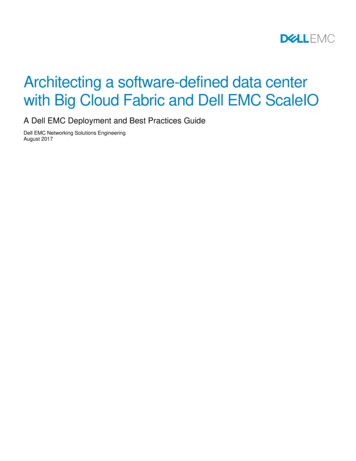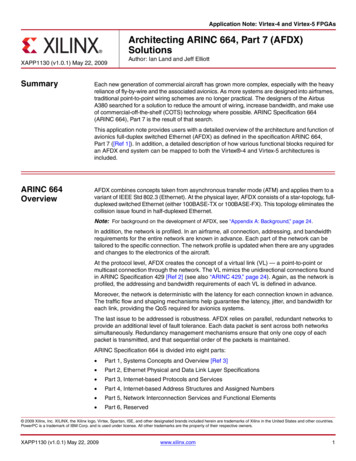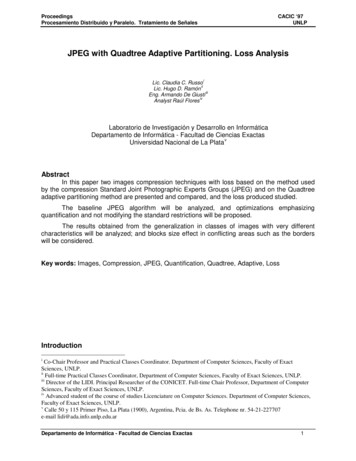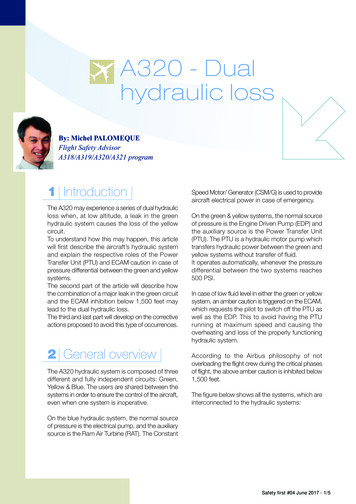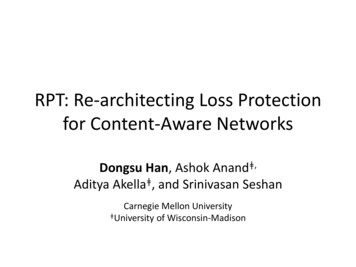
Transcription
RPT: Re-architecting Loss Protectionfor Content-Aware NetworksDongsu Han, Ashok Anandǂ,Aditya Akellaǂ, and Srinivasan SeshanCarnegie Mellon UniversityǂUniversity of Wisconsin-Madison
Motivation:Delay-sensitive communicationSoft-realtimeintra-data centercommunication[DCTCP, D3]Response time 250msReal-time streams:FaceTime, Skype, on-line games.Maximum one way latency 150msTime critical interdata centercommunication[Maelstrom]Minimizing data loss in time-critical communication isimportant, but challenging because of the time constraint.2
Loss protection today:Redundancy-based recoveryForward Error CorrectionDelayBandwidth for robustnessRedundantpackets (n-k)Originalpackets (k) FEC couples delay with redundancy Small batch size makes FEC more susceptible to bursty loss Difficult to tune parameters (n and k) [TIP2001,INFOCOM2010]Amount of redundancy 20% 50% in Skype video[Multimedia’09]3
Content-aware networkschanges the trade-off of redundancyContent-aware networks caching contentaware processing to remove duplicatesCaching effectively minimizes the bandwidth cost of redundancyREcacheREcacheExamplesRedundancy elimination (RE)[SIGCOMM’08]Bandwidth overhead of 100% redundancy: 3%Content-Centric Networking (CCN) [CoNEXT’09]4
Deployment ofcontent-aware networks Product: WAN optimizers (10 vendors)– Cisco, Riverbed, Juniper, Blue Coat Systems– E.g., Cisco deployed RE on 200 remote offices.– Corporate networks Riverbed: 50 corporate customers, datacenter deploymentsIsolation fromCross trafficMainofficeWANoptimizerBranchVPN (“Virtual wire”)WANoptimizer5
Redundant Packet Transmission (RPT) Introduce redundancy in a way that thenetwork understandsRPTredundantRE NetworkFECRedundancy Elimination RouterQuestions/Challenges How do we make sure we retain the robustness benefits? How much redundancy is needed? How does it compare with FEC? Is this safe to use?6
Redundant Packet Transmission (RPT) Introduce redundancy in a way that thenetwork understandsRPTRE NetworkFECRedundancy Elimination RouterQuestions/Challenges How do we make sure we retain the robustness benefits? How much redundancy is needed? How does it compare with FEC? Is this safe to use?7
RPT on Redundancy Elimination (RE) NetworksRE cache holds packets received during the past 10 secsLoss model: Congestive packet loss that happens inside a router.Decompressed packetCompressed (deduplicated) packetPacketsA’ A’ ncy EliminationRouter8
Redundant Packet Transmission Introduce redundancy in a way that thenetwork understandsRedundant TransmissionRE Networks9
Redundant Packet Transmission Introduce redundancy in a way that thenetwork understandsRE NetworksBenefits: Retain the robustness benefits of redundancy Minimize the bandwidth cost Application can signal the importance of data. (Fine-grained control)10
A Case Study of RPTRedundant Packet Transmission (RPT)- Send multiple copy of the same packet.- Send every packet r times.- Applied to live video in RE networks.Redundant Packets TransmissionHop-by-hop RE networksPartially content-aware networksSmartRE networksNetworks with link-layer lossTime-criticalcommunicationContent Centric Networks (CCN)11
Analytical Comparison with FECFEC(n 10,k 8)2% random loss. 𝑝 0.02DelayBatch size (n 10)0.50Fraction of OverheadFEC(10,5)0.40 FEC(10,6)0.30FEC(10,7)0.20FEC(10,8)Original pkts (k d data loss rate (%)1E 01E 1Redundancy (r 3)NaiveNaive2% data loss0 overhead12
Analytical Comparison with FEC2% random loss. 𝑝 0.020.50Fraction of EC(10,7)FEC(20,14)RPT(4)0.001E-61E-5FEC(n 20,k 16)DelayBatch size (n 20)RPT(3)1E-41E-3 (r)0.300.20NaiveFEC(10,9)Original pkts (k 16)RPT(2)1E-21E-11E 01E 1End-to-end Data loss rate (%)13
Analytical Comparison with FEC2% random loss. 𝑝 0.020.50Fraction of SchemeMax Delay@1MbpsFEC(10,7)168 msFEC(20,16)300 msFEC(100,92) 1300 1E-11E 01E 1Skype video call 128 300kbpsSkype (HD) 1.2 1.5MbpsEnd-to-end Data loss rate (%)14
Experimental Evaluation Thorough evaluation on 3 different aspects of RPT– End user performance– Ease of use (parameter selection)– Impact on other traffic Methodology– Real experiment– Trace based experiment– SimulationCIF: 352x28815
Evaluation Framework RE router implementation (Click, NS2) Video quality evaluation using evalvidSenderNetworkReceiverRPT(r,d)RPTMeasure BW ealistic Cross trafficVideo SourceFECREMeasure lossrate, videoquality (PSNR)16
E2E Performance: Video Quality38Encoded video at sender(Before loss)Average PSNR (dB)3736353433323130RPTFEC17
E2E Performance: Video Quality38Encoded video at senderPacket loss rate 2%37Average PSNR (dB)Received video36353433323130RPTFEC18
E2E Performance: Video QualityRPT(3) Overhead 6%FEC(10,9) Overhead 10%Naïve UDP1.8dB 3dB difference in quality19
E2E Performance:overhead and robustnessPacket loss rate 2%0.4NaiveFraction of eRPT(2)1E-021E-011E 001E 01End-to-end Data Loss Rate (%)20
Impact on other trafficOther Flows RPT flows get prioritized.Packet loss rate : 9%.LossSender(Before loss)9% lossReceiver (Non-RPT)(After loss)RPT FlowsReceiver (RPT)(After loss)OriginalRedundancy00 0.80.850.90.951LossBandwidth use (Mbps)Throughput reduction: 2%21
Is flow prioritization a problem? Not a problem: Important flows should be prioritized. Problem: Unfair bandwidth allocationTCP throughput : 18MbpsTCP throughput: 12Mbps How do provide fairness and robustness at the same time? Core problem: RPT flows are not reacting to congestion. Apply TCP-friendly rate control to RPT. Challenge: correctly accounting for possible changes in loss pattern22
Other results in the paper Demonstration of RPT in a real-world setting– E.g., Emulated corporate VPN scenario Trace-based experimental resultsDetailed parameter sensitivity studyNetwork safety (impact on the network)Design and evaluation of TCP-friendly RPTStrategies on other content-aware networks23
Generalized RPT Many sophisticated schemes are enabled by FEC.– Priority encoding transmission (PET), unequal error protection(UEP), multiple description coding (MDC) Prioritization within a flow for graceful degradation of qualityRedundancy eliminationnetworks [SIGCOMM’08]UEPP-framePET/MDCI-frameVery important: Sent x3 (byte-level redundancy)Important: Sent x224
Conclusion Key Idea of RPT: Don’t hide, expose redundancy! Key Features– High robustness, low overhead user performance– Ease of use: parameter selection, per-packetredundancy/delay control– Flow prioritization Applicability– Applies to delay-sensitive communications in contentaware networks in general.25
26
Product: WAN optimizers (10 vendors) –Cisco, Riverbed, Juniper, Blue Coat Systems –E.g., Cisco deployed RE on 200 remote offices. –Corporate networks Riverbed: 50 corporate customers, datacenter deployments Deployment of content-aware networks 5 Main office Branch WAN optimizer W
